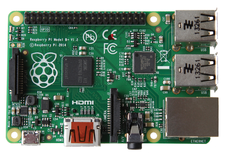Exploring the new Rasp Pi Model B+
Pi Plus

© Lead Image © Raspberry Pi Foundation
The brand new Raspberry Pi Model B+ is solid and tidy, with many clever improvements in detail that make this the best version so far. The desired improvement in performance will have to wait for now.
More than three million Raspberry Pi computers have already been sold. Originally designed to introduce school children to computers, the tiny device has been used as a small server, a media center, an embedded PC in industrial products, and more. The queen of England even honored the project with a visit, and she was amused.
In July, a refurbished Rasp Pi appeared in the form of the Raspberry Pi Model B+. Although the board for this model is still based on the Broadcom-SoC-BCM2835 with 512MB of main memory, the Raspberry Pi Foundation implemented many improvements in its details (see "Why No Improved Performance?"). Users who need more RAM or gigabit Ethernet will have to wait for another model: According to the Foundation, the next Rasp Pi will appear at the end of 2016 at the earliest.
First Impression
A quick look at the circuit board of the Raspberry Pi Model B+ reveals a spiffed up layout. Although the B+ is the same size as the old Model B, it is easier to grab thanks to its rounded edges. Moreover, four holes make it possible to fasten the housing and other accessories more securely. The large capacitor that stuck out so prominently on the Model B and was easy to break off is gone, thanks to the cleaned up power circuitry, and the USB and Ethernet ports now connect flush with the circuit board. The audio out jack moved to the opposite side of the board behind the Ethernet port, but the connectors for camera and GPIO generally remain in the same places.
[...]
Buy this article as PDF
(incl. VAT)
Buy Linux Magazine
Subscribe to our Linux Newsletters
Find Linux and Open Source Jobs
Subscribe to our ADMIN Newsletters
Support Our Work
Linux Magazine content is made possible with support from readers like you. Please consider contributing when you’ve found an article to be beneficial.

News
-
Linux Mint 22.3 Now Available with New Tools
Linux Mint 22.3 has been released with a pair of new tools for system admins and some pretty cool new features.
-
New Linux Malware Targets Cloud-Based Linux Installations
VoidLink, a new Linux malware, should be of real concern because of its stealth and customization.
-
Say Goodbye to Middle-Mouse Paste
Both Gnome and Firefox have proposed getting rid of a long-time favorite Linux feature.
-
Manjaro 26.0 Primary Desktop Environments Default to Wayland
If you want to stick with X.Org, you'll be limited to the desktop environments you can choose.
-
Mozilla Plans to AI-ify Firefox
With a new CEO in control, Mozilla is doubling down on a strategy of trust, all the while leaning into AI.
-
Gnome Says No to AI-Generated Extensions
If you're a developer wanting to create a new Gnome extension, you'd best set aside that AI code generator, because the extension team will have none of that.
-
Parrot OS Switches to KDE Plasma Desktop
Yet another distro is making the move to the KDE Plasma desktop.
-
TUXEDO Announces Gemini 17
TUXEDO Computers has released the fourth generation of its Gemini laptop with plenty of updates.
-
Two New Distros Adopt Enlightenment
MX Moksha and AV Linux 25 join ranks with Bodhi Linux and embrace the Enlightenment desktop.
-
Solus Linux 4.8 Removes Python 2
Solus Linux 4.8 has been released with the latest Linux kernel, updated desktops, and a key removal.

